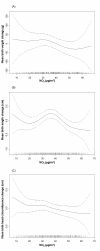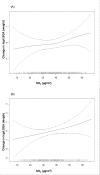Air pollution exposure during pregnancy and reduced birth size: a prospective birth cohort study in Valencia, Spain
- PMID: 20113501
- PMCID: PMC2845572
- DOI: 10.1186/1476-069X-9-6
Air pollution exposure during pregnancy and reduced birth size: a prospective birth cohort study in Valencia, Spain
Abstract
Background: Maternal exposure to air pollution has been related to fetal growth in a number of recent scientific studies. The objective of this study was to assess the association between exposure to air pollution during pregnancy and anthropometric measures at birth in a cohort in Valencia, Spain.
Methods: Seven hundred and eighty-five pregnant women and their singleton newborns participated in the study. Exposure to ambient nitrogen dioxide (NO2) was estimated by means of land use regression. NO2 spatial estimations were adjusted to correspond to relevant pregnancy periods (whole pregnancy and trimesters) for each woman. Outcome variables were birth weight, length, and head circumference (HC), along with being small for gestational age (SGA). The association between exposure to residential outdoor NO2 and outcomes was assessed controlling for potential confounders and examining the shape of the relationship using generalized additive models (GAM).
Results: For continuous anthropometric measures, GAM indicated a change in slope at NO2 concentrations of around 40 microg/m3. NO2 exposure >40 microg/m3 during the first trimester was associated with a change in birth length of -0.27 cm (95% CI: -0.51 to -0.03) and with a change in birth weight of -40.3 grams (-96.3 to 15.6); the same exposure throughout the whole pregnancy was associated with a change in birth HC of -0.17 cm (-0.34 to -0.003). The shape of the relation was seen to be roughly linear for the risk of being SGA. A 10 microg/m3 increase in NO2 during the second trimester was associated with being SGA-weight, odds ratio (OR): 1.37 (1.01-1.85). For SGA-length the estimate for the same comparison was OR: 1.42 (0.89-2.25).
Conclusions: Prenatal exposure to traffic-related air pollution may reduce fetal growth. Findings from this study provide further evidence of the need for developing strategies to reduce air pollution in order to prevent risks to fetal health and development.
Figures



References
-
- Glinianaia SV, Rankin J, Bell R, Pless-Mulloli T, Howel D. Particulate air pollution and fetal health: a systematic review of the epidemiologic evidence. Epidemiology. 2004;15:36–45. doi: 10.1097/01.ede.0000101023.41844.ac. - DOI - PubMed

